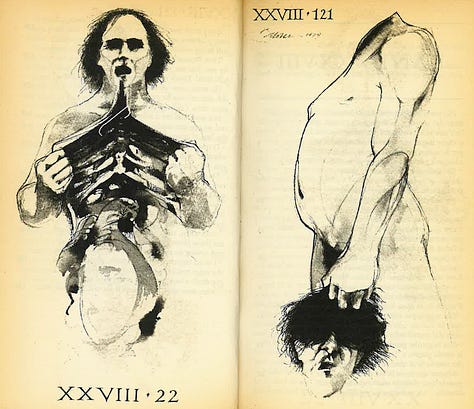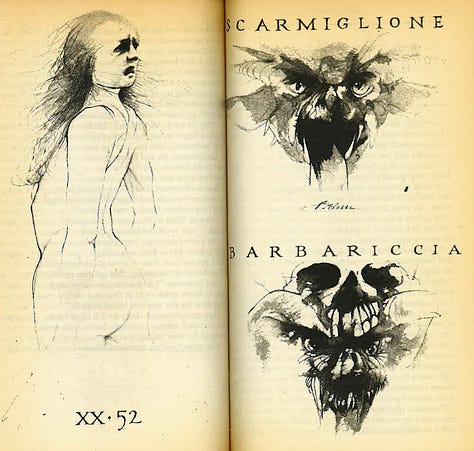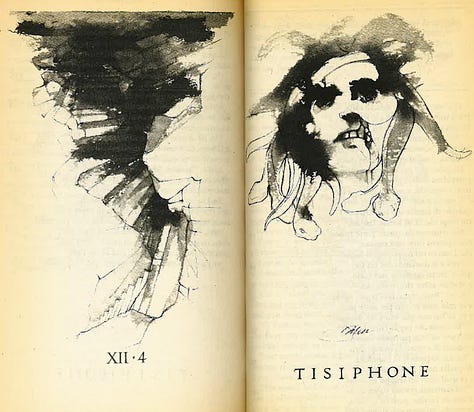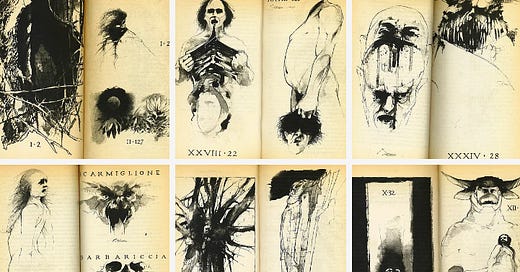The Inferno is the most entertaining first third of Dante’s Divine Comedy—if you have enough schadenfreude to find the interminable suffering of the fallen multitudes amusing. As I explored last time, languishing in the first ring of Hell called Limbo, these poor condemned here harbor no hope for any redemption. The Hell-arrived are given no secret escape passage to Heaven.
Hell hath so much fury it comes in 9 circles, and the circles deeper down beget further circles, as the writhing criminals spin out into increasing wretchedness. I love numbers and shapes—and true crime—so scramble all my favorite things into a prose poem and you have an elaborately structured, if torture-tinged, journey to the depths of Hell. Depending on your earthly infractions, you’ll need to pack all kinds of torrential rain-, pain-, excrement-, and flame-PPE. So consider this part two of the Number 9 series, and part three on the Punished. I bid you Satan-speed or whatever you might say when God has clearly left the building, if ever God was in it.
Let’s start with a handy map to guide us, care of Barry in my 1982 Inferno edition (more on the artist below):
The left panel is a fascinating diagram depicting the universe according to Dante, which spans from Empyrean, the flowery highest height of heaven, through “primum mobile” and “fixed stars” to planets, the moon, descends the stairs of purgatory, lands on Earth, and burrows inside this mortal ball to Hell, should you cut open the hemispheres like a watermelon. On the right, drilling into Hell in more detail, is a precarious inverted pyramid read from the top down, as it seems Hell is generally represented as funnel-like with the top layers being the widest entry-level rings lowering into tighter rings until you hit the center/bottom of Hell where Satan himself hangs out with the world’s worst.
To each ring, its own brand of criminals, and their conditions get denser, uglier, and more complicated (and therefore take up more pages to describe them) as you go, namely:
Limbo — See last time, for the pre-Christian or unbaptized, who, through no fault of their own, get to linger forever “upon the brink of an abyss” for the crime of being too young or too historic.
Lust — Where the “catalogue of cardinal sinners” are “forever buffeted by violent storm.” Just hearing their heartbroken tale makes poor romantic-poet tourist Dante faint.
Gluttony — The over-indulgers, “supine, are flailed by cold and filthy rain and tormented by Cerberus,” a three-throated barking doglike beast. And the constant “downpour makes the sinners howl like dogs.” Dogs are a theme here.
Greed — The miserly strike each other, bald, and don’t recognize each other, as they busy themselves rolling weights in opposing semi-circles, which to me sounds like trading Crypto.
Anger — The wrathful and the sullen are “besmirched by the muddy Styx, the latter immersed in it.” Hell’s multi-layered cake is spliced with these various toxic and mean rivers.
Heresy — Those who go against the grain of acceptable beliefs are entombed in “red-hot sepulchers” flaming and with a foul stench.
Violence — Starting at this 7th circle for violent acts, things starting getting hectic with subsets—a menu of punishments in different rings within the main circle for various shades of infractions. Violence against others (getting immersed in a “boiling river of blood”); against self (committing suicide transforms you into a “strange tree” in a “dreary wood”); and lastly against God (renders you “supine on fiery sands” or “endlessly crossing beneath the rain of fire.”) “Supine” is a recurring position for those in Hell but not the fancy chaise lounge type of supine we might prefer.
Fraud — “Behold the one whose stench fills all the world!” Another theme: Hell doesn’t smell good. As was noted earlier in the journey, “fraud is man’s peculiar vice; God finds it more displeasing—and therefore, the fraudulent are lower, suffering more.” The 8th ring is interestingly comprised of pouches, a whole set of “Malebolge,” where fraudsters might be plunged in excrement or wear their heads backwards, experiencing a “hideousness hard to relay.” I can’t help but wonder what our 45th Prez with his 34 guilty counts—a self-described germaphobe—would have to say about this fecal matter of fraud. As the verbiage and pages increase here in the lower depths of Hell, ironically the harder it is for our author to share it (“hideousness hard to relay”). So it goes with the role of an artist, to try to articulate the unspeakable. The words do find a way. One highlight of Hell is another of my favorite things: the “astounding metamorphosis” undergone by some beasts who merge and reform.
No ivy ever gripped a tree so fast
as when that horrifying monster clasped
and intertwined the other’s limbs with its.
Then just as if their substance were warm wax,
they stuck together and they mixed their colors,
so neither seemed what he had been before…Then two heads were already joined in one,
when in one face where two had been dissolved,
two intermingled shapes appeared to us…And every former shape was canceled there;
that perverse image seemed to share in both—
and none; and so, and slowly, it moved on.Treachery — People who say “when hell freezes over” might not realize this supposedly already happens in the 9th ring, the central pit or “well of Hell” where Cocytus, the last river, ices over. Traitors might gnaw on each other’s hands here, their tears forever frozen in place, and our author Dante, as stunned witness again loses his words, this time for real. “I cannot write it, all words would fall far short of what it is.” Namely this is where he finds the infamous treacherous Brutus, Judas, and Cassius mangled and “gushed together like a bloody froth” in the multi-mouths of Lucifer, the ultimate fallen Angel. (And someday, when I’m feeling really ambitious and dark, maybe I’ll tackle his story in Paradise Lost.)
It’s interesting to me to compare this list of crimes that go straight to Hell (do not pass Go; do not collect $200) with the list and structure Dante establishes from Purgatory, as quoted in my last post:
First, he imagines Purgatory as being divided up into seven terraces, each one corresponding to a vice (in the order that Dante sees them: Pride, Envy, Wrath, Sloth, Avarice and Prodigality, Gluttony and Lust.
In the kinder terraces of Purgatory, there’s a few crimes that overlap with those in Hell (Lust, Gluttony, Wrath, Greed) and do come with the possibility of Heaven should one repent before death. But there are, saved for Hell alone, these bleak areas of no overlap—Heresy, Violence, Fraud, Treachery—which might explain why these lower rings are so overpopulated. There’s nowhere else for these sad sacks (shall we say, the Malebolged) to go.
For now, from the burning heat beach to the frozen Satanic tear/streams when words finally fail us and Heaven is absolutely inaccessible, it’s time for the images. My edition of Inferno was most memorable to me from decades ago largely due to these compelling ink renderings by Barry Moser throughout, which I’ll share here in a gallery of the darkest art, in no particular order:









For cleaner copy that doesn’t come from scans of a yellowed book, visit online the Massachusetts gallery who represents him here. R. Michelson Galleries introduces Barry as,
Since 1969, when he composed his first line of hand-set type, Moser has illustrated some of this century’s most beautiful private press books. World renowned for his children’s illustrations, wood engravings, watercolors, and reinterpretations of the classics, including the Pennyroyal Press editions of Alice in Wonderland, Through the Looking Glass, Frankenstein, Huckleberry Finn, The Wizard of Oz, and the Pennyroyal Caxton Edition of The Holy Bible, Barry Moser’s art is represented in numerous library and museum collections. His work has been published in more than two hundred books for children and adults.
What a list of greatest hits to illustrate. Had I come across a Moser-tinged Bible in my formative years, I might have spent more time complying in summer church camp and less daydreaming on the fast track to Hell.






Really cool art!
It's amusing (and also kind of terrifying) that more Christians probably believe in Dante's version of hell than... well, there is literally no mention of hell in the bible, but you sort of need some kind of mechanism in place to get people to believe besides the carrot of heaven, don't you?
Always loved the idea of Lucifer being damned in the ice place.